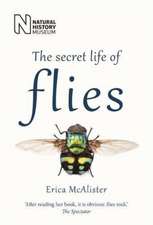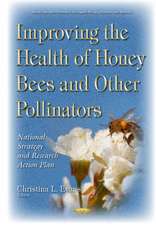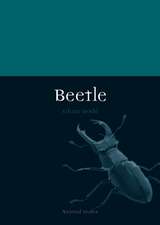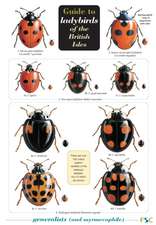Four Wings and a Prayer: Caught in the Mystery of the Monarch Butterfly
Autor Sue Halpernen Limba Engleză Paperback – 30 iun 2002
In Four Wings and a Prayer, Sue Halpern sets off on an adventure to delve into the secrets behind this extraordinary phenomenon. She visits scientists and butterfly lovers across the country, offering a keenly observed portrait of the monarchs’ migration and of the people for whom they have become a glorious obsession. Combining science, memoir, and travel writing, Four Wings and a Prayer is an absorbing travelogue and a fascinating meditation on a profound mystery of the natural world.
Preț: 96.93 lei
Nou
Puncte Express: 145
Preț estimativ în valută:
18.55€ • 20.16$ • 15.59£
18.55€ • 20.16$ • 15.59£
Carte disponibilă
Livrare economică 01-15 aprilie
Preluare comenzi: 021 569.72.76
Specificații
ISBN-13: 9780375701948
ISBN-10: 037570194X
Pagini: 224
Ilustrații: 2 MAPS
Dimensiuni: 132 x 204 x 15 mm
Greutate: 0.24 kg
Ediția:Vintage Books.
Editura: Vintage Publishing
ISBN-10: 037570194X
Pagini: 224
Ilustrații: 2 MAPS
Dimensiuni: 132 x 204 x 15 mm
Greutate: 0.24 kg
Ediția:Vintage Books.
Editura: Vintage Publishing
Recenzii
“Infused with love, emboldened with passion, graced with flickers of transcendence. . . . Sentence by sentence this is an exceptional book.” —The Chicago Tribune
“A charming, sophisticated, and dryly witty account of this most beguiling of insects and the engaging fold who make up its devouts.” —The Seattle Times
“Nature writing at its best. [Halpern’s] spare, direct prose gracefully weds scientific passion with poetic precision.” —The Christian Science Monitor
“Sue Halpern is hot on the trail of one of nature’s more intriguing mysteries. . . . Full of fascinating fact and conjecture delivered in clear layman’s language.” —The Boston Globe
“A charming, sophisticated, and dryly witty account of this most beguiling of insects and the engaging fold who make up its devouts.” —The Seattle Times
“Nature writing at its best. [Halpern’s] spare, direct prose gracefully weds scientific passion with poetic precision.” —The Christian Science Monitor
“Sue Halpern is hot on the trail of one of nature’s more intriguing mysteries. . . . Full of fascinating fact and conjecture delivered in clear layman’s language.” —The Boston Globe
Notă biografică
Sue Halpern is the author of Migrations to Solitude. Her work has apeared in Granta, The New York Review of Books, The New York Times, Audubon, Mother Jones, Rolling Stone, and Orion, among other publications. She lives with her husband and daughter in a small town in the Adirondack Mountains of New York.
Extras
Chapter 1
Bill Calvert eased his truck off Interstate 281 near McAllen, Texas, pulled into a mall parking lot, and drew a knife from his knapsack. It was late in the day, about eight o'clock, and he had been driving for the past five hours.
"What you want to do is make the cut like this," he said, unfastening his belt buckle and the top button of his jeans. He peeled back the waistband to reveal the smallest of incisions. "Nothing too obvious."
Calvert pressed on the fabric, and it opened, exposing a tunnel the width of two fingers. He reached in and extracted a wad of cash that was folded to the size and shape of a stick of gum. Three hundred dollars, it looked like.
"You try," he said, handing over the knife.
I got out of the truck and began to slice at the inside of my jeans. People walked by, mothers and fathers towing small children, for the most part, but also the occasional solitary individual or couple, and if they found it odd to see a woman with a knife in her hand fiddling with her pants not two hundred yards from Montgomery Ward, they weren't saying.
"It's so uncomfortable to walk around with money in your shoes," Calvert was explaining. "It gets real damp. And smelly. This is much better."
We were ten miles from the Mexican border. I threaded my money into its hideaway and followed Calvert into the mall restaurant, a Luby's cafeteria. We were the only diners.
"I always come here before I go to Mexico," he said happily, sliding his tray along the steam table and overloading it with plates of green beans, broccoli, and peas, all of which looked like they had been through the wash. "These are the last green vegetables we'll see for two weeks." I couldn't say I was sorry.
Bill Calvert is a biologist. Not the kind of biologist who wears a lab coat and not, especially, the kind who has a lab. He works out-of-doors most of the time, observing and cataloging and trying to come to terms with natural phenomena. Among people who study monarch butterflies, which is what he himself has done for the past twenty-five years, Calvert is considered the best field researcher in the pack. This may have something to do with the fact that Bill Calvert isn't really part of a pack. He works by himself, getting grants here and there and leading trips for science teachers and wealthy ecotourists, just scraping by. Although he has a doctorate in zoology, academia doesn't interest him. A "real" job doesn't interest him. Calvert is fifty-eight years old. Going to Mexico to look for monarchs-what we were doing-interests him.
"I took an aptitude test when I was in my thirties, and I scored two sigmas past a seventeen-year-old for 'desire for adventure,' " he said a couple of hours after we crossed the border at Reynosa, as he leapfrogged eighteen-wheelers along the rutted two-lane Mexican highway to Cuidad Victoria, where we planned to stop. It was close to midnight. We had just breezed through two military checkpoints with the words "Biologico" and "Mariposa monarca," and now ours was the only passenger vehicle on the road.
"I thought you weren't supposed to drive at night in Mexico," I said to Bill, who smiled at me and tugged on his mustache.
"Why not?" he asked thoughtfully, as if it were a real question.
"Bandits," I said.
"Maybe," he said, and smiled again. It was an enigmatic smile, nothing comforting.
I didn't know Bill Calvert. Or rather, I had known Bill Calvert for about ten hours, ever since he picked me up at the Austin airport earlier in the day. He was late, and I had begun to have my doubts, but then he'd rushed through the door and though I had never before laid eyes on him, I recognized him instantly and was reassured. He was a familiar type. Tall, thin, with a professorial mop of graying hair and an abundant white mustache, wearing stiff Wranglers, a plaid shirt, and scuffed brown shoes. Glasses. A sunburned neck. Mischievous eyes. Pens in his pocket. We had talked twice on the phone before that, too-I was interviewing him for an article I was writing-and it was during one of these conversations that he mentioned he would be driving to the International Conference on the Monarch Butterfly in Morelia, Mexico, the following month, looking for butterflies along the way and doing some research, and invited me to come along.
This would be my second trip to Mexico to see monarchs. The first had been three years before, when my daughter was nine months old. That was how I would always remember the trip, with a certain amount of distance, as if I had been watching myself there: a woman in a foreign country with a small baby in her arms. We had been at a meeting, my husband and I, and at the end of it, as a kind of reward, we were to be taken into the mountains to a monarch butterfly preserve. Those words, butterfly preserve, meant nothing to me. I could not make them into a coherent image the way I could, say, Walt Disney World, where I had never been, either, or Glacier National Park, or Victoria Falls. What would a butterfly preserve look like?
We took a bus, and then a truck, and then we walked. At ninety-five hundred feet, where the climb began, the air was not so thin that you noticed, yet, how high you were. Other things were more obvious and would have taken your breath away even at sea level: the skinny little boys, for instance, who were selling things-recapped bottles of beer and snapshots of clustered monarchs and handkerchiefs embroidered by their mothers or grandmothers or sisters. The handkerchiefs cost a quarter, and though they were made by hand, all of them looked alike: a white cotton square with scalloped edges and an orange-and-black monarch butterfly sewn into one of the corners. That was the other thing that brought me up short: the butterflies. They were underfoot. I was used to seeing butterflies in the air, or on flowers, but there, at the entrance to El Rosario, thousands of wings torn from their bodies lay in the dirt. They were like cairns in the forest, pointing upward, and so we climbed, my husband, our daughter, and I, and the little boys fell away, and I could hear myself breathing, and my heart in my ears, and when I looked up again, what I was seeing made so little sense that I turned it into something else, something I understood-autumn leaves, falling through the air. That was what it sounded like, too. Millions of leaves, ripped and ripping from their moorings. The sound was overwhelming. It woke the baby in my arms, who opened her eyes to this sight. The three of us stood there, looking and looking, and gradually it occurred to me, gradually it registered, that though there were millions of them, they were not leaves at all, they were butterflies, monarch butterflies, the butterflies of my backyard. They were in the air, and so heavy on the branches of the pine trees that the branches bent toward the ground, supplicants to gravity and mass and sheer enthusiasm.
We moved on. As we hiked we saw even more butterflies, more than would seem possible, twenty or thirty million. Every available place to roost was taken. Even the baby became a perch. There were butterflies on her shoulder and shoes, butterflies in her hair. Somehow she knew not to touch them, and not to be afraid. We found a rock at the edge of the forest, and the baby and I sat down. The clamor of butterfly wings was as constant and irregular as surf cresting over rocks. I watched my daughter watching the butterfly resting on her shoelace, watched her reach down and wait until the butterfly crawled up the ladder of one of her fingers, climbed over the hump of knuckles, and rested on the back of her hand. She was completely silent, as if she had lost her voice. Her eyes were wide open, and so was her mouth, and for twenty minutes, maybe longer, the two of us just sat, eleven thousand feet up the side of a mountain, and paid attention. If I were a more religious person I would have called that place, and that moment, holy, or blessed. But my vocabulary did not typically include those words. Still, unbidden, they were the ones that came to mind.
As a child I collected rocks. Limestone, sandstone, mica, quartz-they all went in my box. Inside the box was a book with pictures of rocks, a field guide against which I would check my specimens, but what interested me most was how they felt in my hand, and their colors and consistency, not what they were called. The boy across the street collected butterflies, which he would pin to a piece of foamcore. Although I didn't have this word for it then-I was eight or nine-I thought it was morbid, which is to say that when my grandfather died the next year and I looked at his body laid out in the casket, rigid and perfect, it reminded me of those butterflies pinned to the board. The rocks, rattling around in my box, seemed more animate and full of possibility. Someday they would be dirt.
All these years later, I hardly remembered the difference between an igneous and a metamorphic rock. What I did remember was the single-mindedness with which I had picked through the woods behind my house, and the pure joy of finding something valuable enough to hold on to. It seemed reasonable to call this passion, and to think of myself-and everyone else-as a collection of passions. What this suggests is that it is not simply our ability to think, to be rational, that distinguishes humans from other species, but our ability to be irrational-to put stones in our pockets because we think they are beautiful.
All of us have experiences that could change our lives if we let them: love, offered suddenly, turning from the mantelpiece, as Delmore Schwartz put it. And that, oddly, was the way it was with me and the butterflies. Not love, exactly, offered suddenly, but a similar quickening of heart and desire-in this case a desire to know, if knowledge was not only information and understanding but experience. I could feel those butterflies tugging on my imagination as if it were a loose sleeve.
"You mean you agreed to spend a week in a car in a foreign country with a man you've never met?" my mother asked in disbelief the night before I left for Austin. She reminded me that I had a small child at home, and a husband. "Promise me you won't drive through Mexico at night," she said finally, and I did. I promised her up and down. And now it was near midnight and I was breaking that promise, doing something that only somebody who scored two sigmas more than a seventeen-year-old might find unremarkable.
"Are you worried?" Bill asked after a while, picking up, perhaps, on my body language, which spelled "tense" in marquee letters.
"Yes," I admitted. "Should I be?"
"I don't know," he said, but with conviction.
Monarch butterflies never fly at night. They can't. Once the ambient temperature drops below fifty-five degrees, they become sluggish, unable to flap their wings. The wings, which are commonly-and erroneously-described as solar panels, don't store energy but instead absorb it directly from the sun and air. Pick a monarch off a tree in the early morning and put it on your palm and it will sit there as if it were tame. Until the sun warms the air, the monarch is stuck paralytically, making it breakfast for certain steel-gutted birds. This is crucial because every autumn, monarchs do something no other butterflies do: they migrate unimaginably long distances. Monarchs born east of the Rockies typically go to Mexico. Those born to the west go for the most part to the California coast. They travel forty-four miles a day on average, but sometimes as many as two hundred, and all of it by day. Unlike songbirds, which often migrate in the dark to elude predators, monarchs are limited to flying out in the open when it is sunny enough for them, and warm enough, and not too windy.
"I think they are up there," Calvert speculated the next day, while the windshield wipers slapped at the morning drizzle as if it were something annoying, like bugs. The sky was gray, and Bill was narrating what we would have been looking at if we weren't looking at a thick curtain of clouds: big mountains, part of the Sierra Madre Oriental, mountains that rise eight and ten and twelve thousand feet into the air. In the foreground there were prickly pear and century plants and scrub grass, beautiful in their own way but hardly majestic. Calvert was sure the monarchs were on the move, but up high, above the fog-an unprovable hypothesis.
"Keep your eyes open," he said. "If you ever see a butterfly flying under these conditions-overcast, with no wind-it'll wreak havoc with all the existing theories." I understood implicitly that he would like this. Rules, even scientific rules, were anathema to him. But it wasn't going to happen; it was a biological impossibility. Thermoregulation was one of the few sure things that scientists knew about monarch migration. The rest-how the butterflies knew when it was time to leave their summer breeding grounds for their overwintering sites thousands of miles away, and how, navigationally speaking, they got to those sites-had stymied them for decades. And so had this: how did monarch butterflies from the eastern United States and Canada, millions of them, end up every year in the same unlikely spot, a remote and largely inhospitable fifty acres of oyamel pine forest ten thousand feet up the southwestern flank of Mexico's Transverse Neovolcanic Mountains?
This last question-how do monarchs find their way back to the same oyamel trees year after year?-remains one of the great unsolved mysteries of animal biology. Monarchs are not guided by memory, since no single butterfly ever makes the round trip. Three or four generations separate those that spend one winter in Mexico from those that go there the next. A monarch butterfly born in August where I live, in the Adirondack Mountains of New York State, for instance, will probably fly all the way to Mexico, spend the winter there, and leave in March. Then it will fly north, laying eggs (if it is female) on milkweed along the Gulf Coast in Texas and Florida before dying. The butterflies born of those eggs will continue northward, breeding and laying more eggs along the way. So will their offspring. By August another monarch, four generations or so removed from the monarch that left my land for Mexico the previous summer, will emerge from its chrysalis hidden among the raspberry canes and do the same thing. It will head south, aiming for a place it's never been, an acre or two of forest on the steep slopes of the Neovolcanics.
From the Hardcover edition.
Bill Calvert eased his truck off Interstate 281 near McAllen, Texas, pulled into a mall parking lot, and drew a knife from his knapsack. It was late in the day, about eight o'clock, and he had been driving for the past five hours.
"What you want to do is make the cut like this," he said, unfastening his belt buckle and the top button of his jeans. He peeled back the waistband to reveal the smallest of incisions. "Nothing too obvious."
Calvert pressed on the fabric, and it opened, exposing a tunnel the width of two fingers. He reached in and extracted a wad of cash that was folded to the size and shape of a stick of gum. Three hundred dollars, it looked like.
"You try," he said, handing over the knife.
I got out of the truck and began to slice at the inside of my jeans. People walked by, mothers and fathers towing small children, for the most part, but also the occasional solitary individual or couple, and if they found it odd to see a woman with a knife in her hand fiddling with her pants not two hundred yards from Montgomery Ward, they weren't saying.
"It's so uncomfortable to walk around with money in your shoes," Calvert was explaining. "It gets real damp. And smelly. This is much better."
We were ten miles from the Mexican border. I threaded my money into its hideaway and followed Calvert into the mall restaurant, a Luby's cafeteria. We were the only diners.
"I always come here before I go to Mexico," he said happily, sliding his tray along the steam table and overloading it with plates of green beans, broccoli, and peas, all of which looked like they had been through the wash. "These are the last green vegetables we'll see for two weeks." I couldn't say I was sorry.
Bill Calvert is a biologist. Not the kind of biologist who wears a lab coat and not, especially, the kind who has a lab. He works out-of-doors most of the time, observing and cataloging and trying to come to terms with natural phenomena. Among people who study monarch butterflies, which is what he himself has done for the past twenty-five years, Calvert is considered the best field researcher in the pack. This may have something to do with the fact that Bill Calvert isn't really part of a pack. He works by himself, getting grants here and there and leading trips for science teachers and wealthy ecotourists, just scraping by. Although he has a doctorate in zoology, academia doesn't interest him. A "real" job doesn't interest him. Calvert is fifty-eight years old. Going to Mexico to look for monarchs-what we were doing-interests him.
"I took an aptitude test when I was in my thirties, and I scored two sigmas past a seventeen-year-old for 'desire for adventure,' " he said a couple of hours after we crossed the border at Reynosa, as he leapfrogged eighteen-wheelers along the rutted two-lane Mexican highway to Cuidad Victoria, where we planned to stop. It was close to midnight. We had just breezed through two military checkpoints with the words "Biologico" and "Mariposa monarca," and now ours was the only passenger vehicle on the road.
"I thought you weren't supposed to drive at night in Mexico," I said to Bill, who smiled at me and tugged on his mustache.
"Why not?" he asked thoughtfully, as if it were a real question.
"Bandits," I said.
"Maybe," he said, and smiled again. It was an enigmatic smile, nothing comforting.
I didn't know Bill Calvert. Or rather, I had known Bill Calvert for about ten hours, ever since he picked me up at the Austin airport earlier in the day. He was late, and I had begun to have my doubts, but then he'd rushed through the door and though I had never before laid eyes on him, I recognized him instantly and was reassured. He was a familiar type. Tall, thin, with a professorial mop of graying hair and an abundant white mustache, wearing stiff Wranglers, a plaid shirt, and scuffed brown shoes. Glasses. A sunburned neck. Mischievous eyes. Pens in his pocket. We had talked twice on the phone before that, too-I was interviewing him for an article I was writing-and it was during one of these conversations that he mentioned he would be driving to the International Conference on the Monarch Butterfly in Morelia, Mexico, the following month, looking for butterflies along the way and doing some research, and invited me to come along.
This would be my second trip to Mexico to see monarchs. The first had been three years before, when my daughter was nine months old. That was how I would always remember the trip, with a certain amount of distance, as if I had been watching myself there: a woman in a foreign country with a small baby in her arms. We had been at a meeting, my husband and I, and at the end of it, as a kind of reward, we were to be taken into the mountains to a monarch butterfly preserve. Those words, butterfly preserve, meant nothing to me. I could not make them into a coherent image the way I could, say, Walt Disney World, where I had never been, either, or Glacier National Park, or Victoria Falls. What would a butterfly preserve look like?
We took a bus, and then a truck, and then we walked. At ninety-five hundred feet, where the climb began, the air was not so thin that you noticed, yet, how high you were. Other things were more obvious and would have taken your breath away even at sea level: the skinny little boys, for instance, who were selling things-recapped bottles of beer and snapshots of clustered monarchs and handkerchiefs embroidered by their mothers or grandmothers or sisters. The handkerchiefs cost a quarter, and though they were made by hand, all of them looked alike: a white cotton square with scalloped edges and an orange-and-black monarch butterfly sewn into one of the corners. That was the other thing that brought me up short: the butterflies. They were underfoot. I was used to seeing butterflies in the air, or on flowers, but there, at the entrance to El Rosario, thousands of wings torn from their bodies lay in the dirt. They were like cairns in the forest, pointing upward, and so we climbed, my husband, our daughter, and I, and the little boys fell away, and I could hear myself breathing, and my heart in my ears, and when I looked up again, what I was seeing made so little sense that I turned it into something else, something I understood-autumn leaves, falling through the air. That was what it sounded like, too. Millions of leaves, ripped and ripping from their moorings. The sound was overwhelming. It woke the baby in my arms, who opened her eyes to this sight. The three of us stood there, looking and looking, and gradually it occurred to me, gradually it registered, that though there were millions of them, they were not leaves at all, they were butterflies, monarch butterflies, the butterflies of my backyard. They were in the air, and so heavy on the branches of the pine trees that the branches bent toward the ground, supplicants to gravity and mass and sheer enthusiasm.
We moved on. As we hiked we saw even more butterflies, more than would seem possible, twenty or thirty million. Every available place to roost was taken. Even the baby became a perch. There were butterflies on her shoulder and shoes, butterflies in her hair. Somehow she knew not to touch them, and not to be afraid. We found a rock at the edge of the forest, and the baby and I sat down. The clamor of butterfly wings was as constant and irregular as surf cresting over rocks. I watched my daughter watching the butterfly resting on her shoelace, watched her reach down and wait until the butterfly crawled up the ladder of one of her fingers, climbed over the hump of knuckles, and rested on the back of her hand. She was completely silent, as if she had lost her voice. Her eyes were wide open, and so was her mouth, and for twenty minutes, maybe longer, the two of us just sat, eleven thousand feet up the side of a mountain, and paid attention. If I were a more religious person I would have called that place, and that moment, holy, or blessed. But my vocabulary did not typically include those words. Still, unbidden, they were the ones that came to mind.
As a child I collected rocks. Limestone, sandstone, mica, quartz-they all went in my box. Inside the box was a book with pictures of rocks, a field guide against which I would check my specimens, but what interested me most was how they felt in my hand, and their colors and consistency, not what they were called. The boy across the street collected butterflies, which he would pin to a piece of foamcore. Although I didn't have this word for it then-I was eight or nine-I thought it was morbid, which is to say that when my grandfather died the next year and I looked at his body laid out in the casket, rigid and perfect, it reminded me of those butterflies pinned to the board. The rocks, rattling around in my box, seemed more animate and full of possibility. Someday they would be dirt.
All these years later, I hardly remembered the difference between an igneous and a metamorphic rock. What I did remember was the single-mindedness with which I had picked through the woods behind my house, and the pure joy of finding something valuable enough to hold on to. It seemed reasonable to call this passion, and to think of myself-and everyone else-as a collection of passions. What this suggests is that it is not simply our ability to think, to be rational, that distinguishes humans from other species, but our ability to be irrational-to put stones in our pockets because we think they are beautiful.
All of us have experiences that could change our lives if we let them: love, offered suddenly, turning from the mantelpiece, as Delmore Schwartz put it. And that, oddly, was the way it was with me and the butterflies. Not love, exactly, offered suddenly, but a similar quickening of heart and desire-in this case a desire to know, if knowledge was not only information and understanding but experience. I could feel those butterflies tugging on my imagination as if it were a loose sleeve.
"You mean you agreed to spend a week in a car in a foreign country with a man you've never met?" my mother asked in disbelief the night before I left for Austin. She reminded me that I had a small child at home, and a husband. "Promise me you won't drive through Mexico at night," she said finally, and I did. I promised her up and down. And now it was near midnight and I was breaking that promise, doing something that only somebody who scored two sigmas more than a seventeen-year-old might find unremarkable.
"Are you worried?" Bill asked after a while, picking up, perhaps, on my body language, which spelled "tense" in marquee letters.
"Yes," I admitted. "Should I be?"
"I don't know," he said, but with conviction.
Monarch butterflies never fly at night. They can't. Once the ambient temperature drops below fifty-five degrees, they become sluggish, unable to flap their wings. The wings, which are commonly-and erroneously-described as solar panels, don't store energy but instead absorb it directly from the sun and air. Pick a monarch off a tree in the early morning and put it on your palm and it will sit there as if it were tame. Until the sun warms the air, the monarch is stuck paralytically, making it breakfast for certain steel-gutted birds. This is crucial because every autumn, monarchs do something no other butterflies do: they migrate unimaginably long distances. Monarchs born east of the Rockies typically go to Mexico. Those born to the west go for the most part to the California coast. They travel forty-four miles a day on average, but sometimes as many as two hundred, and all of it by day. Unlike songbirds, which often migrate in the dark to elude predators, monarchs are limited to flying out in the open when it is sunny enough for them, and warm enough, and not too windy.
"I think they are up there," Calvert speculated the next day, while the windshield wipers slapped at the morning drizzle as if it were something annoying, like bugs. The sky was gray, and Bill was narrating what we would have been looking at if we weren't looking at a thick curtain of clouds: big mountains, part of the Sierra Madre Oriental, mountains that rise eight and ten and twelve thousand feet into the air. In the foreground there were prickly pear and century plants and scrub grass, beautiful in their own way but hardly majestic. Calvert was sure the monarchs were on the move, but up high, above the fog-an unprovable hypothesis.
"Keep your eyes open," he said. "If you ever see a butterfly flying under these conditions-overcast, with no wind-it'll wreak havoc with all the existing theories." I understood implicitly that he would like this. Rules, even scientific rules, were anathema to him. But it wasn't going to happen; it was a biological impossibility. Thermoregulation was one of the few sure things that scientists knew about monarch migration. The rest-how the butterflies knew when it was time to leave their summer breeding grounds for their overwintering sites thousands of miles away, and how, navigationally speaking, they got to those sites-had stymied them for decades. And so had this: how did monarch butterflies from the eastern United States and Canada, millions of them, end up every year in the same unlikely spot, a remote and largely inhospitable fifty acres of oyamel pine forest ten thousand feet up the southwestern flank of Mexico's Transverse Neovolcanic Mountains?
This last question-how do monarchs find their way back to the same oyamel trees year after year?-remains one of the great unsolved mysteries of animal biology. Monarchs are not guided by memory, since no single butterfly ever makes the round trip. Three or four generations separate those that spend one winter in Mexico from those that go there the next. A monarch butterfly born in August where I live, in the Adirondack Mountains of New York State, for instance, will probably fly all the way to Mexico, spend the winter there, and leave in March. Then it will fly north, laying eggs (if it is female) on milkweed along the Gulf Coast in Texas and Florida before dying. The butterflies born of those eggs will continue northward, breeding and laying more eggs along the way. So will their offspring. By August another monarch, four generations or so removed from the monarch that left my land for Mexico the previous summer, will emerge from its chrysalis hidden among the raspberry canes and do the same thing. It will head south, aiming for a place it's never been, an acre or two of forest on the steep slopes of the Neovolcanics.
From the Hardcover edition.
Descriere
Halpern undertakes an enchanting study of the monarch butterfly: its awe-inspiring annual migration and the scientists and amateurs who are obsessed with this evanescent creature. Line drawings.














